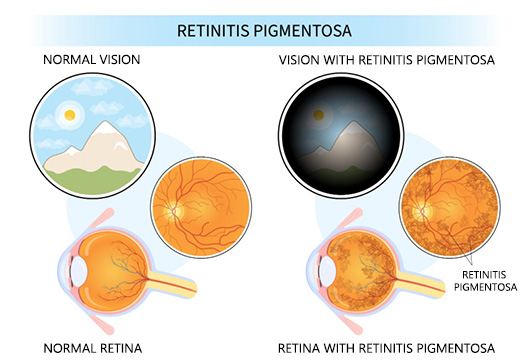Retinitis Pigmentosa Treatment in Ayurveda- Causes, Symptoms & Herbal Remedies
Abstract
Eyes make us see the beauty of nature. Eye disorders are very irritating and troublesome as seeing is one of the most common things we require to do to perform any activities. Some conditions of the eyes are developed over time or sometimes infections can lead to eye diseases and refractive errors are occured due to anatomical and non nutritious diets. There are other conditions of the eyes that are genetic or hereditary. Among such genetic eye disorders, Retinitis Pigmentosa is there, which is, though, inaccurate as the condition is not manifested as inflammation of the retina but the atrophy or degeneration of the retinal pigment epithelium (however inflammation can be there sometimes). In this article, we shall discuss the condition of Retinitis Pigmentosa and its management.

Introduction
Retinitis Pigmentosa is a primary retinal dystrophy which is a hereditary disorder that affects the rods more than the cones of the retina. Both the eyes are usually affected in this condition. Male are more affected than females with a ratio 3:2. Symptoms often begin in childhood with difficulty seeing in low light (night blindness) and gradual loss of peripheral vision, eventually affecting central vision. Retinitis Pigmentosa can be caused by mutations in various genes, and its progression varies among individuals. In Ayurveda, the condition is correlated with beej dushti or more precisely beej bhag dushti that makes the person prone to development of the disease that occurs over time. Let’s now have a look into some details of Retinitis Pigentosa.
Causes Of Retinitis Pigmentosa
Inheritance
Most common mode is autosomal recessive, followed by autosomal dominant. X linked recessive is the least common.
Clinical Features
Visual Symptoms
- Night blindness is the characteristic feature and may be present much before the changes in the retina. It happens because of the degeneration of the rods.
- Dark adaptation : Light threshold of the peripheral retina is increased.
- Tubular vision can be there in advanced stages.
Fundus Changes
- Retinal pigmentary changes are typically perivascular and resemble bone bone corpuscles in shape. In the beginning, changes seen in equatorial regions however spread anteriorly and posteriorly later. Retinal arterioles are narrow and may change into thread like in advanced stages.
- Optic disc becomes waxy and pale in later stages and ultimately optic atrophy occurs.
- Colloid bodies, cystoid macular edema,choroidal sclerosis and atrophic maculopathy are other associated changes that can be seen.
Visual Field Changes
Ring or Annular scotoma is a classical feature which corresponds to the degenerated zone of the equatorial retina. It can increase anteriorly and posteriorly with time and can lead to blindness.
Electrophysiological Changes
- Electro-oculogram shows absence of light peak
- Electro-retinogram is subnormal or abolished
Associations Of Retinitis Pigmentosa
- Ocular associations : Myopia, microphthalmos, posterior subcapsular cataract, primary open angle glaucoma and conical cornea.
- Systemic associations : Laurence-Moon-Biedl syndrome, Refsum’s syndrome, Hallgren’s syndrome, Usher’s syndrome and Cockayne’s syndrome.
Management
- To stop progression include vasodilators, placental extracts, transplantation of rectus muscles into suprachoroidal space, light exclusion therapy, ultrasonic therapy and acupuncture therapy.
- Low vision aids (Night vision device and magnifying device)
- Rehabilitation
- Prophylaxis
Ayurvedic View And Management
Ocular diseases in Ayurveda are covered under Shalakya Tantra. There are various causative factors that lead to dysfunctioning in the eyes. In Retinitis Pigmentosa, as the condition is genetic, in ayurveda it can be related with beej dushti/beej bhaga dushti. When beej bhag is contaminated with the aggravated dosha the conditions like blindness, limpness and other abnormalities occur. Beej bhag can be related to chromosomes and any alterations in beej bhag results in the genetic conditions. Likewise, Retinitis Pigmentosa is a genetic condition which by the symptoms resembles some of the types of timira such as nakulandhya and doshandha i e night blindness. However, Vitiation of tridosha is there in this condition and the condition can be managed to a good extent with ayurvedic herbs.
Management includes virechna karma, as pitta and kapha dosha are usually more involved in causing the diseases of the eyes. Therefore, vireacha (purgation) is indicated in eye disorders. Virechna helps strengthen all the indriyas. Hence, purgation therapy helps in managing this condition and also strengthens the eyes and its functioning. Nasya karma helps in Retinitis Pigmentosa by strengthening retinal epithelium and maintaining existing vision as the olfactory nerve pathway is connected with hypothalamus and limbic system. Therefore, nasya stimulates higher centres in the brain. Tarpana (route of ocular drug delivery through topical administration) is used in vataja-pittaja netra rogas. Tarpana helps in strengthening the eyes by providing nourishment to the eye tissue. Medicines that are helpful in Retinitis Pigmentosa are vyasthapaka herbs such as amalaki (Emblica officinalis), haritaki, rasna, punarnava, shatavari, jivanti and chaksushya dravyas like pippali, chitrak, amalaki and others.
Medicated ghee formulations such as maha triphala ghrita, triphala ghrita, jeevantyadi ghrita are useful in this condition. Seka with triphala kashaya, yashtimadhu kashaya, lodhra kashayaand aschotana with jeevantyadi ghrita, tarpana with jeevantyadi ghrita. Oral medications such as saptamrita loha and triphala ghrita, netrashni rasa, dadhimarich yog, aja yakruta with pippali churna etc are helpful. Nasya with anu taila, shirodhara with kshirbala taila and tarpana with jivantyadi ghrita have good results.
Herbal Remedies For Retinitis Pigmentosa By Planet Ayurveda
Planet Ayurveda is a known ayurvedic company and herbal manufacturing unit. Planet Ayurveda has been serving people with adverse and severe conditions successfully. Planet Ayurveda’s products are highly effective and potent and are made in accordance with the ancient ayurvedic formulation texts. The products are free of chemicals and preservatives. Products also devoid of colors, additives and sweet enhancing synthetic flavors. Planet Ayurveda takes care of and maintains all the quality standards. Planet Ayurveda is pleased to present its some products that help manage the condition of Retinitis Pigemntosa very effectively. The list of products are as follows:
- Angel Eye Vitale
- Saptamrit Loha
- Mahatriphala Ghrit
- Yasthimadhu Ghan Vati
- Jivantyadi Ghrit
Products Description
1. Angel Eye Vitale
Angel Eye Vitale is a patent product of Planet Ayurveda filled up with the eye’s health enhancing properties of amla (Emblica officinalis), gotukola (Centella asiatica) and bhringraj (Eclipta alba). These herbs are very good for eyes as they contain essential elements and possess properties such as antioxidants that are needed to slow down the progression of Retinitis Pigmentosa. They maintain healthy blood flow to the retina and hence provide nutrition to the retinal tissues.
Dosage : 1-2 Capsules once or twice daily after meals.
2. Saptamrit Loha
Saptamrit Loha is a herbomineral classical ayurvedic medicine for eye disorders. It is composed yasthimadhu (Glycyrrhiza glabra), loha bhasm (Iron calx), amalaki (Emblica officinalis), vibhitaki (Terminalia bellirica) and others. Saptamrit Loha helps in slowing the progression of the disease which is the focus of the management. Saptamrit Loha is known to support general eye health and potentially help by improving circulation, reducing inflammation, and providing essential nutrients. The iron content in Saptamrit Loha helps in improving the overall metabolic activity of the body, including that of the eye tissues. The herbs and minerals in the formulation have antioxidant properties that are known to protect retinal cells from oxidative damage, which plays a role in the progression of Retinitis Pigmentosa.
Dosage : 2 tablets twice a day with Honey and Ghee after meals.
3. Mahatriphala Ghrit
Mahatriphala Ghrit is a classical Ayurvedic formulation beneficial in managing Retinitis Pigmentosa (RP). It is enriched with herbs such as Triphala—Amalaki (Emblica officinalis), Bibhitaki (Terminalia bellirica), and Haritaki (Terminalia chebula)—along with Bhringraj (Eclipta alba), Shatavari (Asparagus racemosus), Giloy (Tinospora cordifolia), Pipal (Ficus religiosa), Mulethi (Glycyrrhiza glabra) and Vasa (Adhatoda vasica). These herbs are known for their potent antioxidant, anti-inflammatory, and rejuvenating properties that help protect and nourish retinal tissues. The ghee base enhances absorption and supports deep ocular nourishment. Regular and guided use of this ghrit slows down the progression of Retinitis Pigmentosa and supports overall eye health naturally.
Dosage : One tsp twice daily with warm water after meals.
4. Yashtimadhu Ghan Vati
Yasthimadhu ghan vati are the tablets composed of roots of Yashtimadhu (Glycyrrhiza glabra). Yasthimadhu has enormous health benefits. The flavonoids and glycyrrhizin compounds in the licorice (Yashtimadhu) neutralize free radicals and help in slowing down the progression of retinitis pigmentosa. Its anti-inflammatory property provides protection to the retinal cells. It also helps in better blood circulation to the retina that helps in nourishing the retina and alleviates symptoms associated with the said condition.
Dosage : 1-2 tablets twice or thrice daily after meals.
5. Jivantyadi Ghrit
Jivantyadi Ghrit is a classical herbal formulation that is known for eye health enhancing properties. Jivantyadi ghrit has various properties such as anti-inflammatory and antioxidant. The ghee is medicated with a number of herbs including Jivanti (Leptadenia reticulata), kakoli (Lilium polyphyllum), lodhra (Symplocos racemosa), shatavari (Asparagus racemosus), yashtimadhu (Glycyrrhiza glabra), amalaki (Emblica officinalis) and other various herbs. It is a unique blend of herbs that are helpful in the management of Retinitis Pigmentosa. Jivanti being an important herb in the formulation provides nourishment to the eye tissues. Anti Inflammatory properties of the formulation help in the management of RP as inflammation of the retina worsen and increases the risk of vision than anticipated. Jivantyadi Ghrit is also known for providing healthy vision. Therefore, Jivantyadi Ghrit is an essential herbal formulation in Retinitis Pigmentosa.
Dosage :
Oral administration : 3 to 6 grams mixed with mishri or as guided by the physician. Aschyotana (Instillation of the drug in the from of drops).
Conclusion
Retinitis Pigmentosa is a genetic condition that affects both the eyes and causes degeneration of the rods cells of the retina. This results in night blindness and gradual loss of vision. As the condition is genetic that cannot be undone but can be well managed and the progression of the condition can be halted or slowed down. In modern ophthalmology the management is the usage of low vision aids, rehabilitation, supplements, managing associated conditions such as cataract surgery and macular edema with medicine. However, there is no sure treatment available. In comparison, Ayurveda does have some therapies and herbal medicines or formulations to offer.




